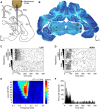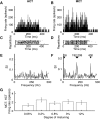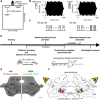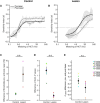A Role for Auditory Corticothalamic Feedback in the Perception of Complex Sounds
- PMID: 28559384
- PMCID: PMC5481946
- DOI: 10.1523/JNEUROSCI.0397-17.2017
A Role for Auditory Corticothalamic Feedback in the Perception of Complex Sounds
Abstract
Feedback signals from the primary auditory cortex (A1) can shape the receptive field properties of neurons in the ventral division of the medial geniculate body (MGBv). However, the behavioral significance of corticothalamic modulation is unknown. The aim of this study was to elucidate the role of this descending pathway in the perception of complex sounds. We tested the ability of adult female ferrets to detect the presence of a mistuned harmonic in a complex tone using a positive conditioned go/no-go behavioral paradigm before and after the input from layer VI in A1 to MGBv was bilaterally and selectively eliminated using chromophore-targeted laser photolysis. MGBv neurons were identified by their short latencies and sharp tuning curves. They responded robustly to harmonic complex tones and exhibited an increase in firing rate and temporal pattern changes when one frequency component in the complex tone was mistuned. Injections of fluorescent microbeads conjugated with a light-sensitive chromophore were made in MGBv, and, following retrograde transport to the cortical cell bodies, apoptosis was induced by infrared laser illumination of A1. This resulted in a selective loss of ∼60% of layer VI A1-MGBv neurons. After the lesion, mistuning detection was impaired, as indicated by decreased d' values, a shift of the psychometric curves toward higher mistuning values, and increased thresholds, whereas discrimination performance was unaffected when level cues were also available. Our results suggest that A1-MGBv corticothalamic feedback contributes to the detection of harmonicity, one of the most important grouping cues in the perception of complex sounds.SIGNIFICANCE STATEMENT Perception of a complex auditory scene is based on the ability of the brain to group those sound components that belong to the same source and to segregate them from those belonging to different sources. Because two people talking simultaneously may differ in their voice pitch, perceiving the harmonic structure of sounds is very important for auditory scene analysis. Here we demonstrate mistuning sensitivity in the thalamus and that feedback from the primary auditory cortex is required for the normal ability of ferrets to detect a mistuned harmonic within a complex sound. These results provide novel insight into the function of descending sensory pathways in the brain and suggest that this corticothalamic circuit plays an important role in scene analysis.
Keywords: auditory cortex; behavior; chromophore-targeted laser photolysis; ferret; harmonic complex tones; medial geniculate body.
Copyright © 2017 Homma, Happel et al.
Figures







Similar articles
-
Lemniscal Corticothalamic Feedback in Auditory Scene Analysis.Front Neurosci. 2021 Aug 19;15:723893. doi: 10.3389/fnins.2021.723893. eCollection 2021. Front Neurosci. 2021. PMID: 34489635 Free PMC article. Review.
-
Corticothalamic feedback for sound-specific plasticity of auditory thalamic neurons elicited by tones paired with basal forebrain stimulation.Cereb Cortex. 2008 Jul;18(7):1521-8. doi: 10.1093/cercor/bhm188. Epub 2008 Jan 17. Cereb Cortex. 2008. PMID: 18203697
-
Mistuning detection performance of ferrets in a go/no-go task.J Acoust Soc Am. 2016 Jun;139(6):EL246. doi: 10.1121/1.4954378. J Acoust Soc Am. 2016. PMID: 27369180 Free PMC article.
-
Frequency-specific plasticity of the auditory cortex elicited by thalamic stimulation in the rat.Neurosci Lett. 2013 Oct 25;555:30-5. doi: 10.1016/j.neulet.2013.09.016. Epub 2013 Sep 13. Neurosci Lett. 2013. PMID: 24036457
-
Physiological and behavioral studies of spatial coding in the auditory cortex.Hear Res. 2007 Jul;229(1-2):106-15. doi: 10.1016/j.heares.2007.01.001. Epub 2007 Jan 17. Hear Res. 2007. PMID: 17314017 Free PMC article. Review.
Cited by
-
The Associative Thalamus: A Switchboard for Cortical Operations and a Promising Target for Schizophrenia.Neuroscientist. 2024 Feb;30(1):132-147. doi: 10.1177/10738584221112861. Epub 2022 Aug 8. Neuroscientist. 2024. PMID: 38279699 Free PMC article. Review.
-
Presynaptic Neuronal Nicotinic Receptors Differentially Shape Select Inputs to Auditory Thalamus and Are Negatively Impacted by Aging.J Neurosci. 2017 Nov 22;37(47):11377-11389. doi: 10.1523/JNEUROSCI.1795-17.2017. Epub 2017 Oct 23. J Neurosci. 2017. PMID: 29061702 Free PMC article.
-
Neural circuits underlying auditory contrast gain control and their perceptual implications.Nat Commun. 2020 Jan 16;11(1):324. doi: 10.1038/s41467-019-14163-5. Nat Commun. 2020. PMID: 31949136 Free PMC article.
-
FOXP2-immunoreactive corticothalamic neurons in neocortical layers 6a and 6b are tightly regulated by neuromodulatory systems.iScience. 2024 Dec 19;28(1):111646. doi: 10.1016/j.isci.2024.111646. eCollection 2025 Jan 17. iScience. 2024. PMID: 39868047 Free PMC article.
-
Corticothalamic feedback locally modulates network state.Sci Rep. 2025 Jul 1;15(1):20606. doi: 10.1038/s41598-025-05592-y. Sci Rep. 2025. PMID: 40592988 Free PMC article.
References
-
- Allon N, Yeshurun Y, Wollberg Z (1981) Responses of single cells in the medial geniculate body of awake squirrel monkeys. Exp Brain Res 41:222–232. - PubMed
MeSH terms
Grants and funding
LinkOut - more resources
Full Text Sources
Other Literature Sources
